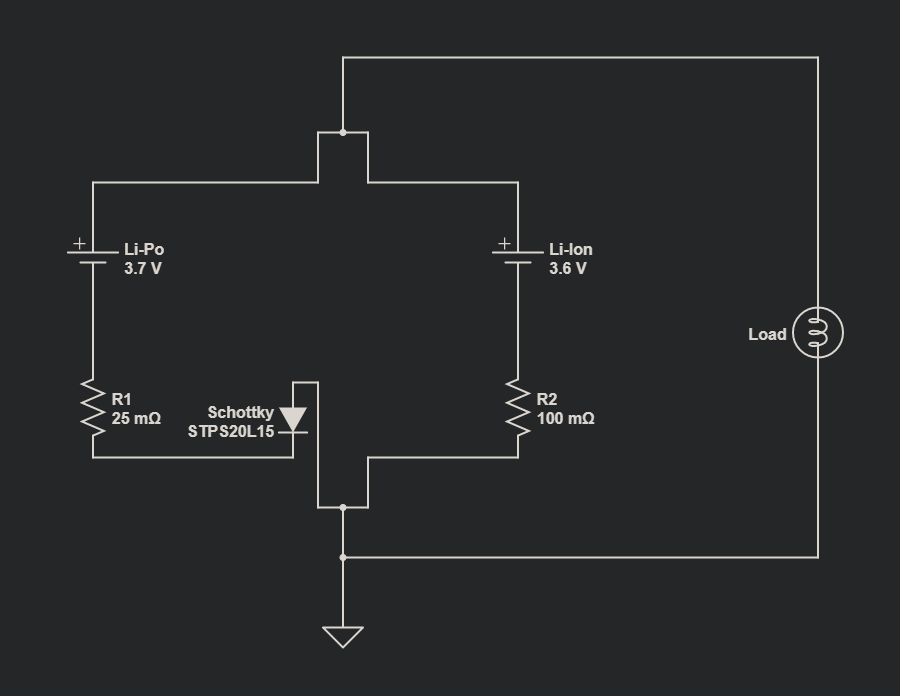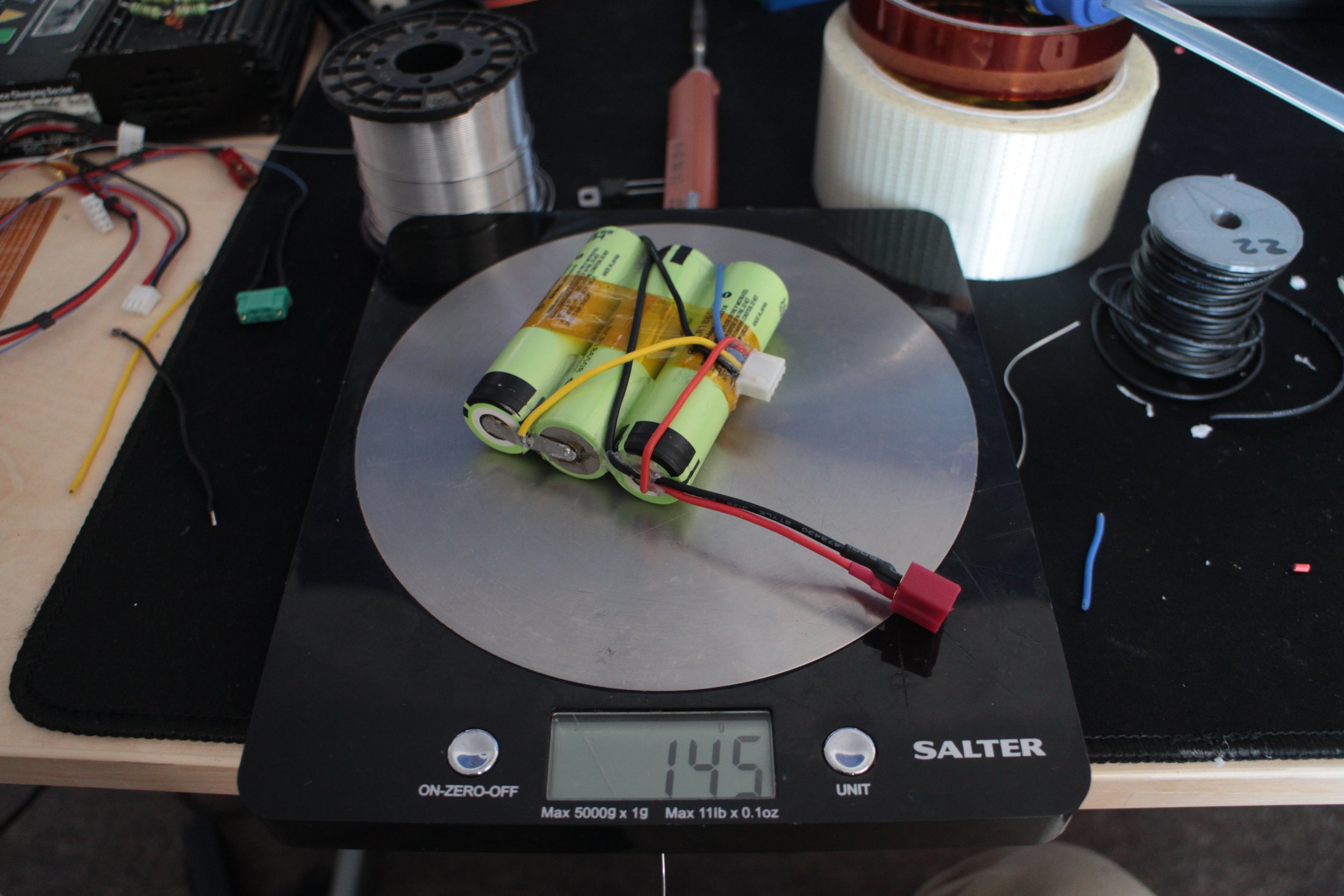May 2019
Hybrid Li-Po / Li-Ion Battery Pack
The idea behind this concept is that most of the time when deciding on what battery you want to use, you must select only one. This is obviously unfavourable because in most situations you would want to pick and choose the advantages of each of the different battery chemistries.
The two most useful battery chemistries tend to be Lithium Polymer and Lithium Ion. Lithium Polymer batteries can have very high charge and discharge currents because of their low ESR and Lithium Ion batteries can have a much higher energy density. For lots (if not most) cases both qualities are wanted. Therefore, it is a natural conclusion that you would want a combination of the two. The problem with this is that because they have different ESRs and different operating voltage ranges they can’t just be connected in parallel.
If the batteries were connected in parallel you would not be able to use the full capacity of the Lithium Ion batteries, because they have a lower minimum voltage of ~2.5V compared to ~3.2V for Lithium Polymer batteries.
Further, in high discharge current events more power would be drawn from the Lithium Polymer batteries due to their lower ESR, and then when the high discharge current event stops the Lithium Polymer batteries would be left with a lower voltage potential than the Lithium Ion batteries. This in turn would cause a current flow from the Lithium Ion batteries to the Lithium Polymer batteries. It is true that this would only happen when there is a change in current draw, but this type of hybrid battery would only be useful in applications where current changes by large amounts, reasonably frequently.
Over time this would cause excessive wear to both sets of batteries and could be dangerous, if this extra current flow causes the batteries to overheat and vent. The same could also potentially happen when charging the hybrid battery.
Existing Products
So far I have been talking as if all Lithium Ion batteries are the same, this is not true. When I have been referring to Lithium Ion batteries, I have actually been more specifically referring to Lithium-Cobalt Oxide batteries. These are by far the most common type of lithium Ion batteries (Here for more info). However, more recently, Lithium-Manganese Oxide Batteries have been becoming more popular due to their higher discharge rates, in exchange for lower energy density. This is exactly the same point that I want to get to with my hybrid battery, but at the moment, Lithium-Manganese Oxide batteries are not as good as they would need to be for some applications.
One representative example is the Samsung INR18650-25R, it has a continuous discharge rate of only 20A and a capacity of only 2500mAh. This is only a slight increase in capacity compared to a standard Lithium Polymer battery (2200mAh at this weight) and it has a massive decrease in discharge rate (easily 60A at this weight).
Although it would be direct ‘competition’ to a hybrid battery, this seems to be a very low bar to clear.
My Solution
My solution is still to connect the two battery chemistries in parallel, but not directly. Instead, there would be a diode between the Lithium Ion and Lithium Polymer batteries that would stop the Lithium Ion battery from discharging into the Lithium Polymer battery. This diode is also advantageous because the voltage drop across the diode would compensate for the lower minimum voltage of the Lithium Ion battery by artificially dropping the voltage of the Lithium Polymer battery.
First I made an Lithium Ion 18650 battery pack using Panasonic NCR18650B cells.
The total weight of a 3s 3400mAh NCR18650B pack is 30g lighter than a 3s 2200mAh Lithium Polymer battery. (this doesn’t equate exactly due to the slightly lower voltage range of Li-Ions, but is close enough)
Two STPS20L15D Schottky Diodes, I’m using these for their low voltage drop of 0.3V at 20A, this is the perfect amount of drop to equalise the battery chemistries, with the current draws that I am expecting.
The two simple harnesses that I made with the Schottky Diodes to connect my two Lithium Polymer batteries with my two Lithium Ion batteries. In the middle of the hybrid battery project I switched battery connectors, hence the difference in battery connectors between photos.
Both of the wiring harneses plugged into the plane.
First Controlled Test
This was flown completely line of sight, which is why the video is quite bumpy and erratic.
Conclusions From First Controlled Test
The plane flew for a total of 1 hour and 3 minutes. Over this time the plane drew 10100mAh for an average of 10A, it drew a peak of 40A and reached a minimum voltage of 8.9V under load. This then recovered after 5 minutes of rest to 9.5V, giving an average cell voltage of 3.15V per cell for the Li-Ion cells and 3.35V per cell for the Li-Po cells.
This is not quite the perfect voltage separation for the different battery chemistries, but this can be chalked up to only using 2x NCR18650B 3s 3400mAh battery packs, compared to the 4 it was designed around.
Also, even in this flight the batteries were not completely depleted, as it could have gone down to 8.6V before causing any significant damage to the Lithium Polymer batteries (this was done to leave a reserve of power for an aborted landing).
Even so, for its weight, it beat a Lithium Ion only battery pack in terms of discharge rate (by double), and it beat a Lithium Polymer battery pack in terms of capacity (by 14%).
When running with the 4x NCR18650B 3s 3400mAh battery packs It was designed around, I would expect these numbers to change to somewhere around 150% better than a Li-Ion for gravimetric discharge rate and 150% better than a Li-Po for gravimetric energy density.
I will have to contnue testing, but it looks very promising.







